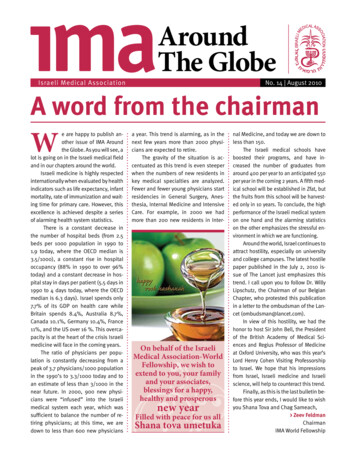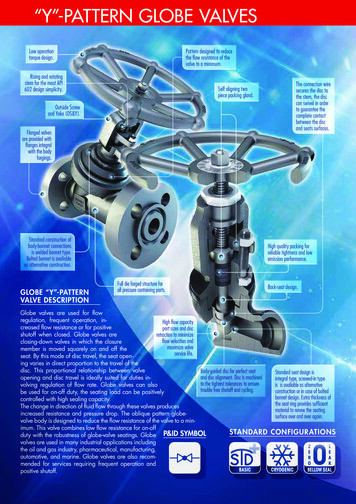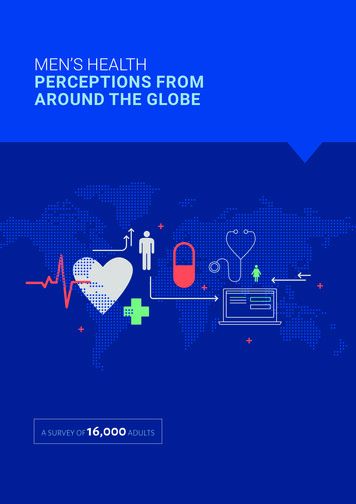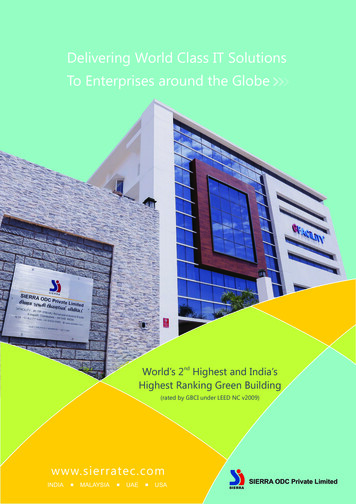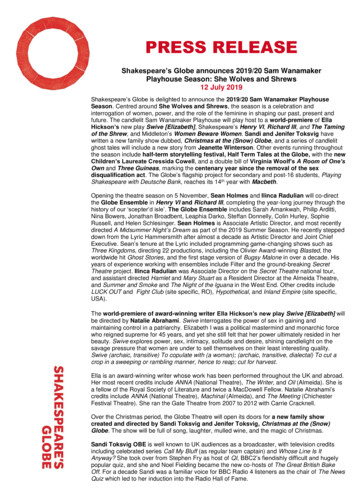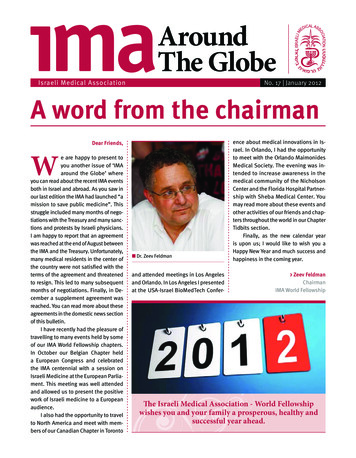
Transcription
Israeli Medical AssociationAroundThe GlobeNo. 17 January 2012A word from the chairmanWDear Friends,e are happy to present toyou another issue of ‘IMAaround the Globe’ whereyou can read about the recent IMA eventsboth in Israel and abroad. As you saw inour last edition the IMA had launched “amission to save public medicine”. Thisstruggle included many months of negotiations with the Treasury and many sanctions and protests by Israeli physicians.I am happy to report that an agreementwas reached at the end of August betweenthe IMA and the Treasury. Unfortunately,many medical residents in the center ofthe country were not satisfied with theterms of the agreement and threatenedto resign. This led to many subsequentmonths of negotiations. Finally, in December a supplement agreement wasreached. You can read more about theseagreements in the domestic news sectionof this bulletin.I have recently had the pleasure oftravelling to many events held by someof our IMA World Fellowship chapters.In October our Belgian Chapter helda European Congress and celebratedthe IMA centennial with a session onIsraeli Medicine at the European Parliament. This meeting was well attendedand allowed us to present the positivework of Israeli medicine to a Europeanaudience.I also had the opportunity to travelto North America and meet with members of our Canadian Chapter in TorontoDr. Zeev Feldmanand attended meetings in Los Angelesand Orlando. In Los Angeles I presentedat the USA-Israel BioMedTech Confer-ence about medical innovations in Israel. In Orlando, I had the opportunityto meet with the Orlando MaimonidesMedical Society. The evening was intended to increase awareness in themedical community of the NicholsonCenter and the Florida Hospital Partnership with Sheba Medical Center. Youmay read more about these events andother activities of our friends and chapters throughout the world in our ChapterTidbits section.Finally, as the new calendar yearis upon us; I would like to wish you aHappy New Year and much success andhappiness in the coming year. Zeev FeldmanChairmanIMA World FellowshipThe Israeli Medical Association - World Fellowshipwishes you and your family a prosperous, healthy andsuccessful year ahead.
IMA AROUND THE GLOBE jAnuary 20122Save Our Public Health SystemAfter many months of a difficult andcomplex struggle, marked by intensivenegotiations, on Thursday the 25th August 2011 a breakthrough agreementwas signed, one which is hoped willchange the face of the public healthsystem.Deterioration of theIsraeli Health SystemIn early 2011, the Israeli Medical Association (IMA) publically announcedthe launch of “a mission to save public medicine,” demanding additionalmanpower, more beds in hospitals, anincrease in physician salaries in theperiphery and incentive pay for doctorsworking in specialties suffering fromphysician shortages.Physicians StrikesOn the 3 April, the IMA announced a2-day warning strike, emphasizing thatalthough we did not want a strike thatcould harm patients, to remain silentat this time would be akin to abandoning future patients. Several demonstrations were staged throughout thesubsequent months of negotiations,including at the Tel Aviv annual marathon, on Israeli Independence Day, onthe festival Lag B’Omer and outsidethe Israeli Parliament.Despite an ongoing series of sanctions and protests launched by the Isrdraeli Medical Association, negotiationswith the government on public healthreform and increased wages for physicians remained unsuccessful. Despitetheir being inconvenienced, publicsupport for the physicians ran high aspeople recognized that the system wasin vital need of repair. Throughout thestrike, the IMA’s “exception committees” worked to ensure that all urgentmedical needs were addressed. Thecommittees approved more than halfof the requests for treatment presented by patients and their doctors. Physicians continued to treat all patientsin life-threatening situations, even ondays of full sanctions.Hunger Strike andMarch to JerusalemOn the 25th July, the IMA held a pressconference at which Dr Eidelmancalled upon the Israeli Prime Ministerand Health Minister, Benjamin Netanyahu, to intervene in the dispute. DrEidelman took leave from his hospitaland began a hunger strike, which hedeclared he would not stop until theend of the conflict.Concurrently, Dr Eidelman began a4-day walk from the IMA offices in Ramat Gan to the Prime Minister’s officein Jerusalem. Throughout the week,protest marches were held at localhospitals and among community phy-A most moving display of support affordedDr. Eidelman by many in the government.whenhe was greeted by a rousing standing ovation”SAVE THE PUBLIC HEALTHSYSTEM IN ISRAELsicians across the country. Dr Eidelmanarrived in Jerusalem on Friday 29th Julywhere he set up a tent outside thePrime Minister’s office. 134 days afterthe physicians declared a labor disputeand following months of negotiations,there was still no agreement.On the 31st July, Dr Eidelman metwith President Shimon Peres. President Peres promised that he wouldspeak with the political leadership inorder to try and reach a solution to thedeadlock in negotiations. Dr Eidelmanrestated his call for Netanyahu to personally intervene.“We were deeply honored to behosted at the residence of the country’snumber one citizen. But it is not honorthat we are looking for; we are lookingfor a solution to the problems plaguing the public health system. We needmore doctors to treat our citizens,”Later that day, approximately 3,000doctors and residents again protestedopposite the Israeli Parliament, demanding a solution to the crisis in thehealth care system. Following the demonstration, the protesters marched tothe Prime Minister’s residence, whereDr Eidelman presented a petition withmore than 30,000 signatures callingfor a solution to save the public healthsystem in Israel.A most moving display of supportafforded Dr. Eidelman by many in thegovernment occurred on the 2nd of August, when he was greeted by a rousingstanding ovation at a meeting of thehealth lobby in the Parliament.
IMA AROUND THE GLOBE january 2012Breakthrough in NegotiationsOn the 3rd of August, a breakthroughwas achieved in the discussions between the IMA and the Ministry of Finance. The state agreed to add 1,000staff positions for doctors in hospitals,effective immediately. The 1,000 jobslots would be fixed in the agreementand would be in addition to allocations to expand the number of hospitalbeds within the next few years. Thestate also agreed to grants of up to300,000NIS (approximately 83,000)for doctors who move to the peripheryor enter specialties where there is amanpower shortage. In addition, thenumber of night and weekend shiftsof 26 consecutive hours would be reduced to six per month. Following thisbreakthrough, Dr Eidelman, ended hishunger strike, which had begun 10days earlier.With hope to end the dispute, andfollowing a hearing in the High Courtof Justice, the Treasury and the IMAentered into accelerated and intensivenegotiations in order to deal with theremaining issues.3The people of Israel will receive abetter quality of medicine in a more equalhealth system.” 1000 new doctor positions in public hospitals A limit to the number of residenton-call shifts: 6 a month Salary increases of between 32%-80% 49% increase in average hourlywage Significant salary increases fordoctors working in the periphery,and a one-time grant of 300,000NIS for doctors who move to theperiphery Salary supplements and specialgrants for doctors who choose towork in specialties with a severeshortage, of up to 300,000 NIS*1 20% of the increases will go into effect immediately, and 70% will bephased in over the next 3 years.Dr. Leonid Eidelman, President ofthe IMA stated: “We set out to bring*Those doctors who both enter these specialties and work in the periphery are eligible forgrants of up to NIS 500,000.about change in public medicine inIsrael and I’m proud to say that weachieved the goal.The road was not easy. Butthroughout the journey we believed inourselves and the importance of thegoal we set.In fact, the change we made to theconcept, that those who work more willget more, and those who invest morein public medicine will earn significantly more, will assure that the peopleof Israel will receive a better quality ofmedicine in a more equal health system.It is important for me to thank themultitudes of doctors who perseveredwith the demonstrations and took anactive part in the long fight. I also sendmy thanks and deep appreciation tothe Israeli public and patients, whostood behind the doctors and showedus their support and tolerance. Youhave given us the power to bring abouta real change.”An Agreement was Reached!After more than five months of a difficult and complex struggle, marked byintensive negotiations, on Thursdaythe 25th August 2011 a breakthroughagreement was signed.The Israeli Medical Associationand representatives of the Treasurysigned a new collective bargainingagreement, which is hoped will changethe face of the public health system.Under the agreement, there will besignificant additions to the health caresystem, including: The addition of more than 2.5 billion NIS in fundingTop: left to right - Dr Noam Benjamin, Dr Hezi Levy, Dr Israel Eilig, Dr Moshe Kostiner, DrNimrod Rahamimov, Dr Tazki Siev-Ner, Adv Leah Wapner, Dr Baruch Yitzhak, Dr Zeev Feldman.Bottom: left to right - Yitzhak Peterburg, Ilan Levin, Dr Leonid Eidelman, MK Yitzhak Cohen,Eli Depes
IMA AROUND THE GLOBE jAnuary 20124SAVE THE PUBLIC HEALTHSYSTEM IN ISRAELIsraeli Medical Residents Threaten to ResignAlthough the Israeli Medical Association struck an agreementwith the Finance Ministry in August,hundreds of medical residents remaineddissatisfied with their work conditionsand submitted letters of resignation.The residents in the center of the country opposed the nine year agreementsigned by the IMA and the Treasury. Theydemanded higher compensation, an improvement in working conditions and tohave the agreement reduced from nineto four years. They also requested that amonitoring committee be set up to trackthe implementation of the agreement.The courts deemed the residents’submission of resignations as an unauthorised collective labour action andaffirmed that the IMA continues to represent all the country’s doctors, includingthe residents.Following the court ruling, more than700 residents submitted new letters ofresignation on a more individual basis.These resignation letters were also rebuffed by the courts. The National LaborCourt persuaded both the residents andthe Treasury, together with the IMA, tocontinue negotiating under court auspices. However, following weeks of courtmediated negotiations, no agreementwas reached.The Finance Ministry suggested allocating funds for solving problems thatmay arise in the coming years and employing specialists in full-time hospitalpositions. They also proposed improvingemployment terms, such as includinga weekly day of rest, providing doctorswith transportation to hospitals and ensuring they are not placed on more thansix on-call shifts a month. Still, no agreement was reached.At the end of October, SupremeCourt Justice Hanan Melcer, sitting asthe High Court of Justice, stated that hewould give the residents two weeks tofind a solution to their labor dispute withthe Treasury.On the 14th November, nearly 250medical residents did not show up forwork. The move came as the court ordered talks with the Treasury failed tomake any progress. The residents hadkept the move quiet to avoid the HighCourt issuing an injunction. The hospitalresidents were joined in the protest by afew dozen medical specialists.The residents inthe center of the countryopposed the nine yearagreement signed by theIMA and the Treasury.They demanded highercompensation and animprovement in workingconditions”A further 200 medical interns failedto show up to work in hospitals on the15th November, in a show of support forthe medical residents. Over 100 seniordoctors from public hospitals also announced their intention to resign in solidarity with the residents. Forty doctorswould resign from Rambam Medical Center in Haifa, forty from Sorosky MedicalCenter in Tel Aviv and a further 20 fromSheba Medical Center at Tel Hashomer,in addition to other hospitals. Most ofthe resigning doctors are affiliated witha newly formed group, the Association ofHospital Doctors, which ostensibly wasset up to compete with the Israeli Medical Association. The doctors opposethe nine-year agreement and especiallyits requirement that they punch timeclocks.The resignations came as approximately 250 medical residents did notshow up for work for the second consecutive day, leaving public hospitals in thecenter of the country understaffed. Workat hospitals in the periphery continuedas usual.The Health Ministry warned that theresidents were acting “in contempt ofcourt” and instructed hospital directorsto tell their residents that if they did notcoordinate their absences with management, they would be violating hospitalrules and the ruling of the National LaborCourt, which had instructed them to return to work.After a week of absenteeism, hundreds of medical residents returned towork at hospitals throughout the country. The negotiations between the government and the residents had come to astandstill and the High Court appointedProf. Moti Mironi, president of the Chamber of Israeli Mediators, and retiredSupreme Court Justice Itzhak Zamir, tomediate the negotiations over the subsequent two weeks.The negotiations were held at theIsraeli Medical Association offices. TheTreasury stated in advance that it wouldnot break the nine-year accord that wassigned with the IMA at the end of August,but that it could make adjustments in or-
IMA AROUND THE GLOBE january 2012der to satisfy the residents.After long discussions exploringsolutions to the issues raised by the residents, a supplementary agreement wassigned on the morning of December 8th,which would improve working conditionsfor doctors, with an emphasis on community residents and young specialists,without taking away from the provisionsof the collective agreement signed onthe 25th August.In the days preceding the signingof the agreement, specialist physiciansin the various hospitals voted on thedetails of the agreement, and their willingness to withdraw the resignationssubmitted if this agreement takes effect.An overwhelming majority were in favourof the draft agreement.Below is a summary of supplementaryagreement reached: Grants for specialist doctors - thedoctors will receive a bonus of20,000 NIS after the first stage oftheir training, and another bonus of40,000 NIS after the second stage. Weekly rest day - Residents will beentitled to an extra day of rest afterweekend duty, in addition to theday of rest they already receive afterevery duty shift. Their weekly day ofrest shall be considered an ordinaryworking day, and not be deductedfrom their salary or vacation days. Monitoring Committee - A monitoring committee will be setup inhospitals, which will include representatives of the hospital administration and representatives of theIMA within the hospital, as well asrepresentatives of the residents.The committee will enforce the maximum number of duty shifts of six amonth and ensure that the weeklyday of rest is also received.5 Compensation for seventh or moreduty shifts - A doctor who worksmore than 6 duty shifts a month willreceive special compensation (in order to provide a negative incentive,employers who assign specialiststo more than six duty shifts a monthwill be fined.)Work on Fridays - Specialists willalso be paid for working more than13 Fridays in a year. On the 14thFriday they work, they will begin to receive extra reimbursement.Specialist interns - Specialist interns in highly-specialist departments may receive compensationfor duty at the rate of 120% of a fullduty tariff.As part of the compromise, the wageagreement and its implementation willbe reexamined after four years, in 2015,and if the parties fail to reach an understanding they will turn to arbitration.Dr. Leonid EidelmanPresidentIsraeli Medical Association8th December 2011Dear Colleagues,Dear Friends,The Israeli Medical Association welcomes the agreement signed this morning after two weeks of intensive dialogue at the IMA offices.I hope that we have paved the way for all publicly employed physicians, including interns and residents, to return to the hospital corridorswith a sense of satisfaction and with their heads held high from the important achievements obtained. I have no doubt that these achievements inthe working conditions of resident doctors will be immediately felt in theirdaily work and will positively affect their quality of life.The collective bargaining agreement and its accompanying agreementsare another step forward for Israeli doctors and the public patients. Thedocument was signed by representatives of the IMA, including residents,as well as by the Ministry of Finance and employers.I thank all those who worked so hard for the doctors and the publichealth system, and especially the young doctors’ representatives who tirelessly worked, in order to achieve the best in the accord.We have much more work ahead of us, and the IMA continues and willcontinue to work non-stop for the doctors and medicine in Israel.Yours Sincerely,Dr. Leonid Eidelman,President, Israeli Medical Association
IMA AROUND THE GLOBE january 20126IMA Domestic News and ActivitiesIsrael’s 5th Medical School isopened in SafedOn the 30th October 2011, the5th medical school in Israelopened in Safed, in the Galilee region.The North of Israel has been increasingly starved of young doctors and it ishoped that the new medical facility willbring medical students and young doctors to the area, as well as to stimulateSafed’s development and raise thequality of medical care in the Northernregion.To mark the school’s opening, PrimeMinister Binyamin Netanyahu heldthe weekly cabinet meeting at the newmedical campus. The opening ceremonywas also attended by President ShimonPeres, Deputy Prime Minister SilvanShalom, Safed Mayor Ilan Shochat andProf. Manuel Trajtenberg, chairman ofthe Council for Higher Education’s Planning and Budgeting Committee."You young people have chosen ‘brain gain' as opposed to ‘braindrain,'" President Shimon Peres stated."By coming here you have eagerly embraced the noble Zionist ideal of developing the northern part of our country.This is the beginning of unprecedentedgrowth in the Galilee region."The new medical school, named theFaculty of Medicine in the Galilee, is connected to Bar Ilan University. Currentlythere are 124 students enrolled in thefour-year program. This has increasedthe number of medical students inthe country by 18 percent. The studentbody currently includes Jews and Arabsreturning from abroad, including thosefrom prestigious institutions such asHarvard, Yale and Stanford universities.The majority of the new facility’s lecturers have also committed themselves toliving in the Galilee region.The new dean of the medical schoolis Prof Ran Tur-Kaspa, a world-renownedexpert in hepatitis viruses and liver disease and the head of Internal MedicineD at the Rabin Medical Center-BeilinsonCampus. Prof Kaspa stated that they expect that the facility will grow to 1,000students within seven years, by whichtime it will move to its permanent quarters overlooking Lake Kinneret.The curriculum has been modelledon that of leading American institutions, such as Harvard Medical School.It features an integrative teaching ap-The stonelayingceremonyfor the newmedicalschool inthe Galilon the 4thApril 2011proach that links core science and clinical studies while communicating to thestudents an orientation toward healthpromotion and disease prevention. Thefaculty will also focus on medical research and plan to establish a researchcenter for the study of autism.New York Mayor Bloombergpresents a new Magen DavidAdom Center in JerusalemOn the 23rd October New YorkMayor Michael Bloomberg presented the newly renovated and expanded Magen David Adom center in Jerusalem. The 30 million NIS renovation wasmade possible by the generous donations of Mayor Bloomberg together withcontributions through the AmericanFriends of Magen David Adom (AFMDA)and other groups from Europe andthroughout the world. The new facilitywas dedicated to the memory ofBloomberg’s father and was named, accordingly, the William H. Bloomberg Magen David Adom Center.In addition to the Bloomberg family, attending the ceremony were thechief rabbis of Israel, Interior MinisterEli Yishai, MDA director-general Eli Bin,Kadima MK and Knesset health lobbychair Rachel Adatto and dozens of foreign donors who were in Israel attendingthe International Magen David AdomConference.The original structure was construct-
IMA AROUND THE GLOBE january 2012ed in 1963 with the aid of funds from theMDA’s South African Friends. The building had become inadequate, after thecity’s vast development and growth, andwas in great need of updating. The emergency facility serves the area’s 1.2 million residents and provides the region’sEMS, ambulance services and suppliesthe area’s hospitals with the majority oftheir blood requirements.The new center was not only upgraded and renovated, adding a new five-story wing, the William H. Bloomberg MagenDavid Adom Center also parades a rangeof new features and improvements. Thecenter was built using modern engineering standards to sustain in the event ofan earthquake, and against threats ofconventional and non-conventional war.The new state-of-the-art dispatchcenter, utilizes the latest GPS technology that can pinpoint every building inthe city and its environs. MDA’s groundbreaking “Motobridge” communicationssystem enables its staff to receive emergency calls and alerts online from everytype of communications device. Thepaid staffers who will use them include66 paramedics, 57 emergency medicaltechnicians and ambulance drivers, 13dispatch center operators, four emergency doctors, four EMS trainers and sixmanagement personnel. The volunteersinclude 1,200 adults and 350 teenagers.The new David Mark Berger Chapter Blood Donation Center, is hoped toboost the number of blood donations,by making donation not just a civic responsibility, but one that can be done incomfort. The fleet of bloodmobiles thatoperate from the station will now be ableto do so easily and efficiently, loadingand unloading supplies, directly into astate- of-the-art Blood Bank.The Nathan and Jacqueline GoldmanPalm Beach Friends MDA Pre-HospitalTraining Center features modern facilities and infrastructure and will run firstaid and other training for the facility.7The new visitors’ center aims to attract people from across the country andabroad as a permanent interactive exhibit about MDA’s history and its wide rangeof life saving activities. The Morris andNancy Offit Conference Center allows forformal programs and educational films.The center also boasts an observationdeck on the roof which overlooks thepanoramic view to the entrance of Jerusalem.The MDA Jerusalem Region is thebusiest in the country. Last year, MDAJerusalem provided medical assistanceto over 53,000 people, rushed close to4,100 women in labor to the hospital(or performed emergency deliveries inambulances or at home), attended tovictims of almost 9,000 road accidentsand provided medical backup at 1,148public events.In his comments at the dedicationceremony, Mayor Bloomberg stated,“My family was attracted to MagenDavid Adom because of its spirit of volunteerism and its unwavering commitment to treat all people equally regardless of race or religion,” he said. “Todayis a great day for Magen David Adom, itssupporters, my family and the people ofJerusalem.”Paramedic licensing exams cannow be taken in EnglishOn the 1st November the Knesset Labor, Social Affairs andHealth Committee approved a bill allowing that state licensing exams forthe paramedical profession to be takenalso in English. Previously, these exams have only been available in Hebrewand Arabic.The change is applicable to examsfor physiotherapists, clinical communications specialists (hearing andspeech), occupational therapists andclinical dieticians.Deputy Health Minister Ya’acov Litzman asked the committee to approvethe regulations for paramedical professionals in order to ease the process oflicensing for new immigrants. For thisreason, licensing exams for doctorshave long been available in a variety oflanguages, and those for nurses havebeen produced in English and Spanishfor a number of years.Representatives of Nefesh B’ Nefesh have asked the chair of the committee MK Haim Katz to add further optional languages for state licensing exams.MK Katz said he was willing to do so.
IMA AROUND THE GLOBE january 20128Medical AchievementsPrinted courtesy of Israel21c - www.israel21c.orgNew ‘solution’ kills hospitalsuperbugsResistant bacteria are soon tomeet their match: a geneticallyengineered fluid that restores their susceptibility to antibiotics.Every patient, nurse, doctor and visitor to a hospital knows the drill: handsget a splash of antibacterial fluid foundat every bedside, entrance and exit.Keeping hands clean can prevent someinfections, but superbugs -- those sometimes deadly bacterial strains resistant toantibiotics -- can outwit the best hygienepractices.Hospital-acquired infections areone of the leading causes of preventable death in the developed world today,with 100,000 people in the United Statesalone dying every year from bugs theycatch as patients in the hospital, according to the World Health Organization. Thesuperbugs may have met their match, thanks toa genetically engineered cleaning solution developedin Israeli laboratories”old and very young are at an especiallyhigh risk of infection from resistant bacteria that can spread like wildfire.But now superbugs may have mettheir match, thanks to a genetically engineered cleaning solution developed inIsraeli laboratories.Costing only a few dollars a quart,the solution is non-toxic to patients andcan be spread on hospital surfaces to killwhat conventional soaps and antibioticscan't, report researchers Rotem Edgarfrom the Tel Aviv Sourasky (Ichilov) Medical Center and Udi Qimron from Tel AvivUniversity. They detailed their technologyrecently in the journal Applied and Environmental Microbiology.To read the full story, click hereDoes that pill cause sideeffects? Treato will tell youIsraeli website aggregates andanalyzes user-generated data torevolutionize the way patients, physicians and drug companies share infoabout medications.Have you just been prescribed anew medication and want to know itspossible side effects? Are you alreadytaking a drug whose side effects aren’tlisted on the package insert? Mostlikely, your first step is to Google it. Butthe unstructured results can be overwhelming and hard to make sense of.That was exactly the problem confronting Gideon Mantel, the CEO and
IMA AROUND THE GLOBE january 20129Treato willrevolutionize the waypatients, physicians,health maintenanceorganizations (HMOs)and pharmaceuticalcompanies integrate usergenerated data into theirinformation processing”co-founder of First Life Research. His17-year-old daughter had suffered abasketball injury and was facing kneesurgery, medication or both. Mantelsearched the web to learn as muchas he could in order to ask the rightquestions of his daughter’s doctors.He spent days combing through postson patient blogs and online bulletinboards.And that led to Mantel’s light-bulbmoment. The former CEO of Israelihigh-tech heavyweight Commtouchwas determined to create a service thatwould aggregate all that patient information in one place, categorized in aneasy-to-understand format.Four years in the making, with 5.5million in venture capital financing,Treato was launched at the end of September at the Health 2.0 conferencein San Francisco. First Life Research isbetting that Treato will revolutionizethe way patients, physicians, healthmaintenance organizations (HMOs)and pharmaceutical companies integrate user-generated data into theirinformation processing.To read the full story, click hereA personal trainer for weakheartsImplantable device invented inIsrael electrically ‘teaches’ diseased heart muscle to contract moreThe minimally invasive Optimizer III is apacemakersized device that electrically stimulatesdiseased heart muscle”strongly and get the blood pumping.For many of the 26 million peoplewith chronic congestive heart failure(CHF), medical treatment fails to gettheir hearts pumping normally. Shortness of breath and general weaknessjust don’t go away, as heart muscledamaged by genetic conditions, heartattack, coronary artery disease or persistent high blood pressure cannot deliver adequate oxygen and nutrients tothe body.A unique potential solution in thepipeline for these patients is now being developed in Israel. The minimallyinvasive Optimizer III is a pacemakersized device that electrically stimulates diseased heart muscle, enablingit to contract more strongly and pumpblood where it’s needed.Implanted in a surgical procedureunder local anesthesia and sedation,the Optimizer III just needs to have itsbattery recharged at home weekly forabout an hour. And it has lasting effects, not just serving as an assistivedevice but actually strengthening theheart the same way any exercise buildsmuscle.In June, Impulse Dynamics enrolled its first patient in a multi-centerstudy to confirm the device’s safetyand efficacy, aimed at getting approvalfrom the US Food & Drug Administration (FDA).To read the full story, click here
IMA AROUND THE GLOBE january 201210International ActivitiesIsraeli Medical Association at theEuropean ParliamentOn the 6th and 7th of November2011, a European Congress wasorganized by the IMA Belgian Chapter inhonor of the Israeli Medical Associationcentennial.The con
Concurrently, Dr Eidelman began a 4-day walk from the IMA offices in Ra-mat Gan to the Prime Minister's office in Jerusalem. Throughout the week, protest marches were held at local hospitals and among community phy-sicians across the country. Dr Eidelman arrived in Jerusalem on Friday 29th July where he set up a tent outside the


